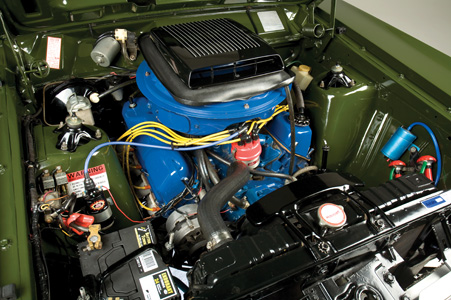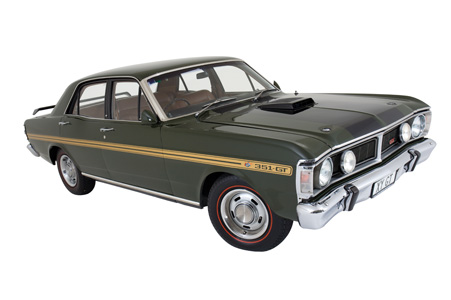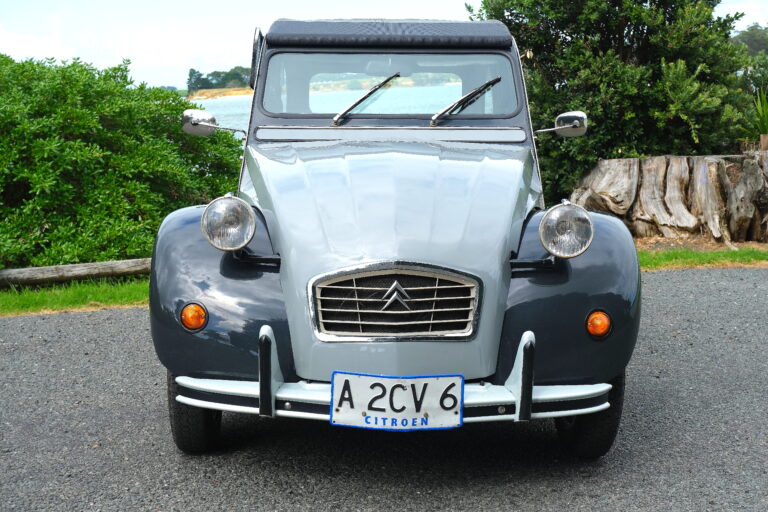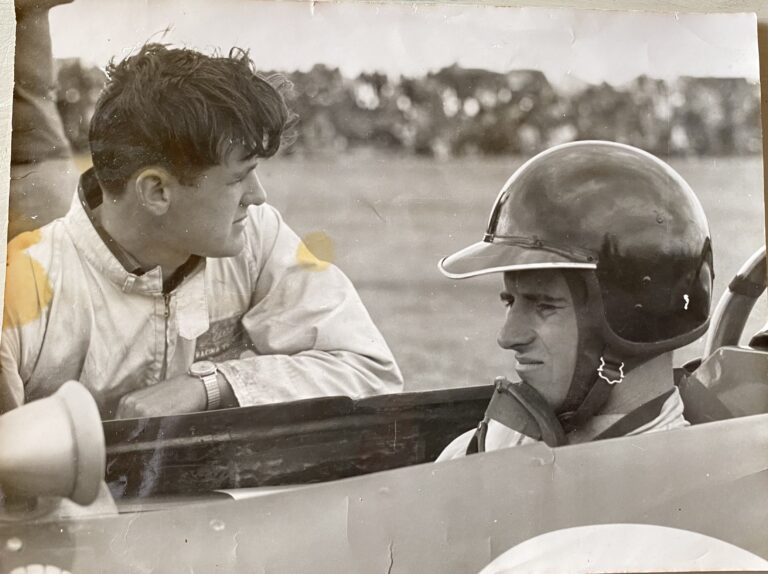data-animation-override>
“Published in New Zealand Classic Car Issue No. 215”

Riding on the back of sky-high prices for the legendary GTHO, the Falcon XY GT is now an appreciating muscle-car asset.
Okay so you’ve just finished spending up large after a recent lotto jackpot win. Your purchases have included an obligatory house upgrade to the northern slopes of Remuera, together with oodles of garage space for a fleet of newly acquired cars — including the Range Rover Sport for whisking the kids to school — and there’s a 12-metre Riviera parked up at Westhaven Marina just for good measure.
Now, you just happen to have a few extra bucks lying around — well, at least when you last counted anyway — and the pressure is on for a wise investment. You know the type of thing, something that’ll help out the kids when they get older. The dilemma you face is where to make that sensible investment!
An investment property perhaps? What about something commercial? Or a diverse share portfolio you can proudly brag about to your new buddies at the local golf club. That all seems to make sound financial sense.
Hang on a minute, though — what about a 1971 XY GTHO Phase III Falcon? Now we’re talking — but at around $700,000-plus, you might have to lower your sights little and opt for the GT version instead. One of those should work out at around $200,000. You might even get a little change if you’re lucky, but if current asking prices for these legendary Aussie beasts are anything to go by then I wouldn’t count on it, even in the current economic climate.
Price bonanza
Most of us are well aware that prices for muscle cars have spiralled out of control over the last few years. But have you ever wondered — what is a muscle car? Depending on who you ask, a muscle car could be almost anything built in the US or Australia somewhere between 1960 and the mid 1970s — and some would also include Corvettes and Mustangs of that era into the same category.
Then there’s the question of price variations. Why? Take two late ’60s Plymouth GTXs for example — one with the 7210cc (440ci) engine and the other with a Hemi of 6981cc (426ci). Fundamentally they are the same car with the exception of about US$500-worth of options (mainly the engine) ordered from the dealer by their first purchaser. Admittedly, there are cars that are significantly rarer than others, but does something like this really justify the tens, even hundreds of thousands of dollars of price difference you can expect today between those two, outwardly similar Plymouths?
Another case in point — across the ditch, you only have to look at the difference in value between a 1970/’71 XY Falcon GT and the XY GT-HO Phase III at today’s prices.
The XY GT Falcon cost A$4240 while the GT-HO was priced at A$5250 when new in 1971 — just over a thousand dollars difference. However, today there can be anything up to a wallet-busting half a million dollars difference between those two cars. Fewer GT-HOs were built than GTs, so the GT-HO is rarer, but nonetheless, the current price differential must seem nutty to most people. At the end of the day, is the GT-HO over-priced, or are GTs a bargain at a fraction of the cost? I guess it all boils down to how much money you’ve got to spend.
Undoubtedly, the typical market dynamics for used cars don’t generally apply where classics are concerned. Emotion plays a much greater part in their purchase. It seems that whenever baby boomers intent on fulfilling their childhood dreams of owning such cars pull out their cheque books, they do so without even considering actual value. They just want to own it because they can. And each purchase sets a new precedent — although I suspect priorities are changing given current, worldwide economic woes.
The XY GT
The acclaimed XY was released in October 1970. The range’s six-cylinder engines were bigger — at 3.3 litres and 4.1 litres — while a 2V (twin Venturi) version of the 351 Cleveland V8 was an option for all sedans.
In late 1970, the new XY GT rolled off the line and was followed in 1971 by the all-time classic GT-HO Phase III, which offered 276kW (370bhp) and 515Nm of torque. An upgraded Cleveland engine in the 1971 XY GTHO Phase III produced in excess of 287kW (385bhp), and was regarded as the world’s fastest four-door production car, with a top speed of 227.7kph (141.5mph).
Power figures are continue to be debated today, as Ford still claims 224kW (300hp) for the standard 351 Cleveland V8 in the GT, though the GT-HO Phase III received many modifications to increase its reliability and race performance.
Looking suitably aggressive with its ‘shaker’ air intake protruding aggressively through the bonnet, a rear deck spoiler and bold side stripes, the Phase III was fitted with a much larger 750cfm carburettor, a bigger radiator, a larger harmonic balancer, better valve train, baffled sump, extractors and a choice of four rear axle ratios.
Predictably, Bathurst 1971 was a Falcon GT feast, with GTHO Phase IIIs finishing in first, second, third, fifth and sixth positions.
Some 1557 XY GTs were made from September 1970 to December 1971, while just 300 GTHO Phase IIIs were built from May to November 1971.
The XY is now widely regarded as the best Falcon made in Australia, not just because of its Bathurst dominance but also because of its performance, build quality and refinement — all of which were superior to its contemporary rivals.
Today, values for XYs compared to other Falcons and their competitors attest to this fact.
Origins of a muscle car
In my opinion, a muscle car is a high-performance car which is generally mid-sized, with a large, powerful engine (more often than not a V8) and unique trim. Intended for maximum acceleration on the street or drag strip these cars are predominantly of American origin, and produced between 1964 and 1971.
Muscle cars are easily distinguishable from sports cars, which are typically smaller, two-seater cars and 2+2 GTs. High-performance full-size or compact cars are questionably excluded from the muscle car category, as are the breed of compact sports coupes inspired by the Ford Mustang, and typically known as pony cars. Having said that, few would dispute the Boss 429’s credentials as a muscle car.
A more exact definition might be based upon power-to-weight ratios — this method would define a muscle car as one with, for example, fewer than 7.3kg per rated kilowatt (12lb per rated horsepower in the old money). However, such a definition is generally deemed as being inaccurate due to the broad inconsistency in kerb weights brought on by various options, and the questionable nature of the SAE gross horsepower ratings in use before 1972. These rating were often intentionally overstated or underrated for various reasons.
There’s also the question of a car’s original design intent. Factory-produced muscle cars that have a larger engine than was originally planned in the design and production phase of the original car can be found in cars throughout America, Japan, and Europe — but that does not make them muscle cars in the classic sense of the term.
The Aussie muscle car
Australia developed its own muscle car culture during the period under discussion, mostly with modified sedans and utility vehicles rather than two-door coupes. Although, of course, we can’t discount the most famous Aussie coupes, such the Holden Monaro — which came with a range of Chevrolet and Australian V8 engines — and the 4343cc (265ci) slant-six E49 or 5211cc (318ci) V8 Valiant Chargers. Also in the Australian muscle car line-up would be the three highest-performance Holden Toranas, the A9X, SLR5000 and the XU-1.
However, when it comes to traditional muscle cars you can’t walk past Ford’s four-door sedan; the ground shaking Cleveland 5752cc (351ci) Falcon GT-HO.
No letters mean more than GT and GT-HO in Australian motor sport history and, when added to the end of the name Falcon XW and Falcon XY, they spell out ‘Australian motor sport legend
.’
Ford’s prodigious machines had a colossal impact on the Australian touring car scene between 1969 and 1973 — the time when a young, up and coming driver by the name of Allan Moffat got behind the wheel of the Phase I, II, and III GT-HOs. Moffat ignited the fervent passion of Ford fans throughout Australasia when he scored top honours at Bathurst in 1970 and 1971.
Birth of a legend
The Falcon GT legend really began in 1967, when Ford Australia’s managing director, Bill Bourke, got straight off the plane from Ford Detroit and spotted the prototype of an impressive-looking XR Falcon V8 police special. This car was being developed by engineers at the company’s You Yangs Proving Ground, and Bourke suggested they develop a production version, paint the cars all one colour (gold) and call them GTs. The Falcon GT was born.
The GT Falcon stands indisputably at the pinnacle of the Aussie muscle car pyramid — and we can thank competition between the big three manufacturers of the day, GMH, Ford and Chrysler, for the GT’s evolution. And, given the fact the GT Falcon has now firmly embedded itself into Australasia motoring history, the XW GT, XY GT and the legendary XY GT-HO Phase III are now regarded as the most collectable cars in Australia.
The first GT, the 1967 XR model, was designed and built in Australia and is still considered by some to be the best GT ever built. Then came the XW GT Falcon with 5751cc (351ci) of absolute pure adrenalin, sporting the legendary Super Roo decal down its flanks side, garish pin-striping and an off-set bonnet scoop. This car was expected to compete at Bathurst from day one.
From there, Ford Australia moved on and produced the HO range of GTs, starting with the Windsor 351 XW GT-HO Phase I Falcon. The 351 Cleveland-based XW GTHO Phase II followed, which could only be purchased with all options just like the XW HOs raced at Bathurst. The letters ‘HO’ are the most sacred in the Australian automotive alphabet and in Falcon GT tradition they stood for ‘Handling Option.’
On today’s Falcon GT there’s nothing optional about fine handling — it’s engineered into the car.
The Weeks Connection
The Weeks bothers — Kerry, David, Chris and Steve — are no strangers to muscle cars, or cars in general for that matter, as they are all involved in the family car sales business.
Over the years the cars the brothers have owned include some of the most desirable available today, and the list reads like a who’s-who of muscle cars. They include two Falcon XW GTs, a Falcon XY GT (our featured car), Falcon XA GT and XB GT, Monaro HT 350, VK Brock Commodore, Group A Brock Commodore, VH Brock Commodore, 1968 RS SS Camaro, 1970 Dodge Challenger, AC Cobra replica and a radical 1970 Plymouth ’Cuda which they still own today The ’Cuda is a step away from their usually preferred classic muscle, as it is highly modified.
The history of our featured GT has an ironic twist as far as the Weeks family is concerned. This 1970 Monza Green XY GT Falcon arrived in New Zealand from Australia in 1973, and apparently passed through several hands before ending up in the ownership of Wayne Unkovich in 1985. Wayne was a friend of the Weeks family. In fact Kerry and David both remember this car from their younger days, and brother Chris would go on to complete his apprenticeship as a motor mechanic under Wayne.
After owning the car for two years Wayne decided to carry out an extensive restoration on the tired GT. The car was stripped down to a bare shell, and once the new door skins were fitted it was repainted in the original Monza Green colour, before receiving a new interior which included fabrics sourced from the UK. The drivetrain and suspension were also completely refurbished, and finished to the original specifications before final assembly.
In 1989 Steve Weeks also owned a GT Falcon, and sold Wayne the Globe wheels to give this splendid-looking XY GT the finishing touch.
Over the next 20 years Kerry and his brothers would often remind Wayne that if the Falcon was ever for sale, they wanted first option. From what I can gather, Wayne was reminded quite frequently — pestered was the word used by Kerry. Their persistence finally paid off and, after 22 years of ownership and 17,700km, Wayne gave in and Kerry purchased the prized XY GT Falcon in 2007. Although Kerry had to sell his pristine AC Cobra to make way for the GT, he felt it was worth it — the Falcon was the car he had always wanted and intended to keep.
A short time later, a Plymouth ’Cuda was offered to Kerry in an unfinished state, and with all the hard work complete, he couldn’t resist the urge to snap up the iconic muscle car.
The Plymouth is now finished and, unfortunately, the Falcon GT had to be sold. It is now in the hands of an enthusiast on the other side of the Bombay Hills.
This may be a good thing for the new owner — out of sight means out of mind and, as far as Kerry is concerned, he may be less inclined to start up another 20-year campaign of pestering if he ever changes his mind about the Falcon GT. [Stop Press: Our featured XY GT was sold by Turners’ Auctions for $200,000 shortly after this article was written]
1970 Falcon XY GT
Engine: Cleveland V8
Capacity: 5752cc (351ci)
Bore/ stroke: 102x89mm
Valves: ohv, two valves per cylinder
C/R: 11.0:1
Max power: 224kW (300bhp) at 5400rpm
Max torque: 515Nm (380lb/ft) at 3400rpm
Fuel system: Four barrel 600cfm Autolite carburettor
Transmission: Four-speed manual
Suspension F/R: Coil springs/ Hotchkiss-type with leaf springs
Steering: Recirculating ball, optional power assist
Brakes: Disc/ drum
Dimensions
O/all length: 4689mm
Width: 1869mm
Wheelbase: 2819mm
Kerb weight: 1524kg
Performance:
Max speed: 217kph
0-100kph: 6.4 seconds
Standing 1/4 mil: 14.2 seconds
Words: Ashley Webb Photos: Adam Croy























